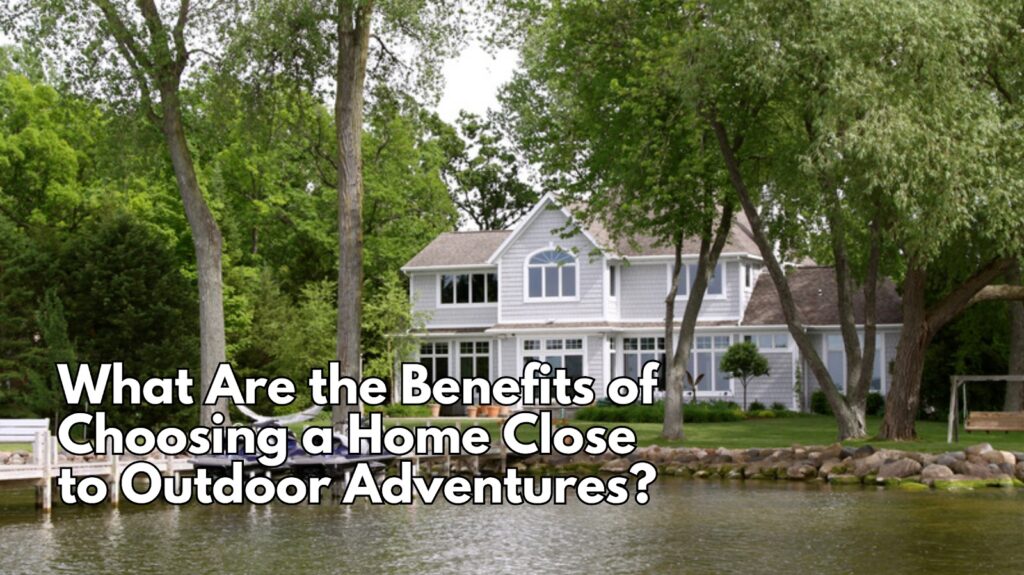Choosing a home is one of the most important decisions in life. A home close to outdoor activities offers significant benefits that enhance the quality of life. These include increased property value and improved health, among others.
How to Choose Your Home
Choosing the right home requires careful consideration. For those who want to be close to outdoor activities, Driggs, Idaho, is an ideal option. Known for its beautiful landscapes and recreational opportunities, Driggs offers a unique blend of adventure and tranquility.
In addition to market trends, the lifestyle offered by Driggs is relevant. In 2007, National Geographic included Driggs on its list of the 10 best outdoor recreation destinations in the U.S. This recognition highlights the town’s attractiveness to outdoor enthusiasts.
It is important to analyze the local market when making deals with trusted driggs idaho real estate agents. According to December 2024 data, the median listing home price in Driggs was $807,000, which is a 27.3% year-over-year increase. This trend shows that the market is robust, and therefore, it would be a good investment.
Health Benefits
Living close to outdoor adventures significantly enhances physical health. The constant exposure to activities like hiking, biking, and skiing keeps one’s cardiovascular fitness high, muscles strengthened, and flexibility improved. Activities in these outdoor environments reduce the chances of developing chronic diseases like heart disease and diabetes.
Another mental health benefit from being close to nature is stress, anxiety, and depression levels are reduced when an individual spends some time outdoors. The natural surroundings create a relaxing atmosphere, enhancing the mood of the individual while boosting overall health.
Outdoor activities also promote social interaction. Participating in a group hike or community event tends to create feelings of belonging while strengthening social connections, which all add up to emotional health.
Economic Gains
Homes near outdoor recreational areas often experience higher property values. The demand for such locations remains strong, leading to appreciation over time. Investing in a home in these areas can yield substantial financial returns.
Additionally, living near outdoor attractions can reduce entertainment expenses. With nature’s playground at your doorstep, costly leisure activities become less necessary, allowing for more budget-friendly recreation.
The local economy also flourishes in areas abundant with outdoor recreation. Recreation-related tourism supports local businesses and creates employment opportunities, thus making for a lively community.
Environmental Impact
Living near nature promotes environmental stewardship. People become more conscious of conservation efforts and are more likely to adopt environmentally friendly practices.
Another advantage is reduced dependence on vehicles. There is less long-distance driving required when recreational grounds are within walking distance, hence less carbon and a smaller footprint on the ecosystem.
In addition, communities next to natural areas tend to incorporate green activities. These activities are aimed at preserving the environment while instilling a sustainability culture among people.
Quality of Life
Exposure to outdoor activities improves the quality of life in general. It provides the avenue for a dynamic and fulfilling life as one engages in various activities.
Families benefit from education from nature. Children who have been exposed to the outdoors have developed curiosity, and they acquire important life skills through exploration.
The aesthetic beauty of nature has also contributed to happiness. Waking up with a scenic view and fresh air promotes a peaceful living condition missing in urban environments.
Community Connection
Living near outdoor recreational places promotes community building among residents. With a common appreciation of nature, people tend to participate collectively in local events and conservation activities.
Community events that are centered on outdoor activities, such as group hikes, clean-up drives, and festivals, allow people to socialize and build relationships.
This community involvement fosters social cohesion and creates a support network among the residents, enriching the living experience.
Accessibility to amenities
Accessibility to outdoor adventures often goes hand in hand with access to essential amenities. Many recreational areas are close to towns that have shopping centers, healthcare facilities, and educational institutions.
For example, Driggs, Idaho, has plenty of outdoor activities, as well as many cultural events like a winter carnival and an old-fashioned rodeo.
This balance of nature and convenience allows the residents to lead a balanced lifestyle without having to compromise on services.
Educational Opportunities
Natural settings near where one lives present unique educational experiences. Nature serves as an open classroom that allows hands-on learning for all ages. Children can see firsthand ecosystems, wildlife, and geology while learning science in a way that creates environmental consciousness.
Adults also enjoy other educational programs in these areas: workshops on topics such as conservation, wildlife photography, and ways of living in harmony with the environment.
Reduction of Stress
The environment is also critical in the reduction of stress due to its quietness. Such an environment brings a momentary relief from everyday activities.
Engagement in outdoor recreation such as hiking or fishing results in a healing influence that reduces cortisol, thus easing the way towards relaxation.
Such stress relief facilitates better sleep, the ability to focus, and mental sharpness, which correlates with enhanced daily performance.
Cultural Enrichment
Many outdoor adventure locations are also cultural heritage sites. Understanding the diversity of those regions allows residents to learn about their way of life.
Festivals, art exhibitions, and historic sites give some insight into the community’s past, which further connects one to the place.
This cultural awareness enhances life experience and opens wider perspectives, further enriching the living environment.
Work-Life Balance
Living near outdoor adventures fosters a better work-life balance. With proximity to nature, residents can have activities that are a mental break from work, reduce burnout, and enhance productivity.
This lifestyle is particularly beneficial for remote workers. Stepping outside to take a quick hike, bike ride, or scenic walk enhances focus and creativity, making workdays more enjoyable and efficient.
Proximity to recreational areas allows families to spend more quality time together, reinforcing relationships and creating lasting memories without the need for long-distance travel.
Increased Recreational Options
Selecting a home near outdoor adventures ensures that there will never be a lack of things to do. Skiing, kayaking, hiking, and fishing are some of the many activities that provide an endless number of opportunities for fun and personal growth.
These activities are designed for all skill levels, making it easy for individuals and families to find something enjoyable. Whether it is a leisurely nature walk or an adrenaline-pumping mountain bike ride, the options are diverse.
Recreational diversity also makes for an active lifestyle, encouraging individuals to unlearn sedentary habits and be physically mobile daily.
Long-Term Investment Value
Real estate around recreational activity areas tends to appreciate over time. With more and more individuals seeking homes with lifestyle benefits, demand continues to build for properties in these areas.
In Driggs, Idaho, the tourism and outdoor recreation business keeps growing; in such areas, property values often continue to rise. Investments there ensure long-term financial stability as well as resale profits.
Homebuyers usually target houses with outdoor attractions like this near a park. Such houses make attractive vacation rentals, too. For example, when a homeowner wants to make money renting part-time while remaining an owner of a valuable asset, that works.
Environmental Consciousness
It is much easier to develop an appreciation for the environment by living close to nature. Many people who live in such areas have adapted to practices like recycling, conserved efforts, and eco-friendly activities.
Many outdoor communities call for responsible tourism and conservation of land. This collective effort perpetuates the principles of responsible land use and conservation. This helps in preserving natural surroundings in all its beauty and healthy conditions for generations to come.
By living an environment-friendly lifestyle, the residents safeguard the local wildlife, forests, and water supply, thus these resources remain safe for recreational as well as ecological purposes.
Better Air Quality
Outdoor-friendly areas tend to have cleaner air compared to a high-density urban metropolis. The presence of lesser industrial pollution along with more greenery provides healthier and fresher air to its residents.
Cleaner air prevents respiratory problems and improves lung function, and health in general. Families with small children or elderly people get various benefits from air pollution-related reduction in an area.
Filtering the pollutants present in the air through natural landscapes also helps prevent exposure to airborne toxins. This brings a healthier home environment and aids in overall well-being.
Locally Sourced Food Availability
Many outdoor-oriented communities support local agriculture, providing fresh, organic food choices. Common in these areas are farmers’ markets, CSA programs, and local dairy or meat suppliers.
Eating locally sourced food will result in the consumption of fewer preservatives and processed ingredients, thus better nutrition and health in general. Residents can also patronize small businesses and sustainable farming practices.
Healthy eating is ensured with seasonal fresh foods while reducing the adverse environmental impacts of food transportation in large quantities as well as minimizing packaging waste.
Conclusion
Opting for a home close to outdoor adventures provides countless benefits, ranging from improved physical and mental health to financial stability and environmental responsibility. Many lifestyle advantages happen that contribute towards overall well-being, and thus, it makes great sense for anyone seeking balance and fulfillment.
For anyone who could be making such a decision, making deals with trusted Driggs, Idaho real estate professionals ensures that purchasing goes as smoothly and informatively as possible. With the strong outdoor scene and even stronger real estate market, Driggs is an opportunity awaiting most homebuyers so that quality is increased.
Ultimately, a home close to nature offers more than just scenic views—it fosters a healthier, more connected, and enriching way of living that benefits both individuals and communities.
Frequently Asked Questions
1. How does living near outdoor adventures impact property value?
Homes in areas with recreational opportunities tend to appreciate over time. The demand for homes in these locations remains high, making them solid long-term investments.
2. What are the factors to consider when choosing a home near outdoor activities?
Accessibility, proximity to essential amenities, local market trends, and year-round recreational options should be considered. Researching the area’s economic and environmental factors is also important.
3. Is living near outdoor activities good for families?
Yes. Families benefit from increased physical activity, better mental well-being, and stronger social connections. It also provides children with unique learning experiences and an appreciation for nature.

